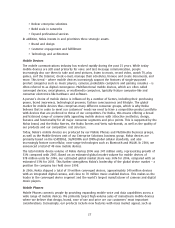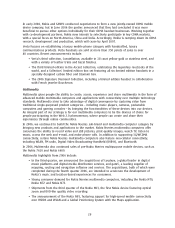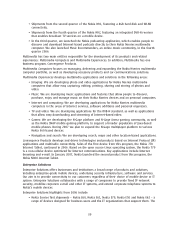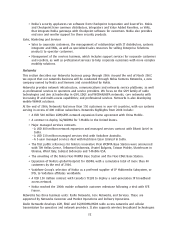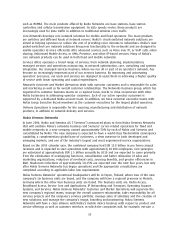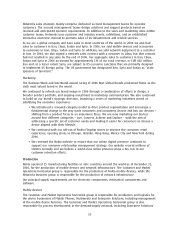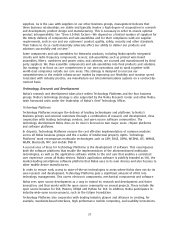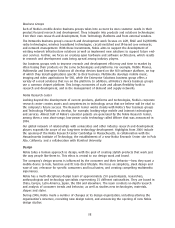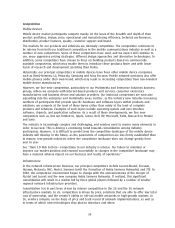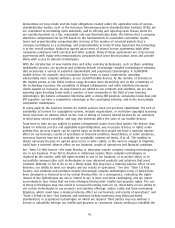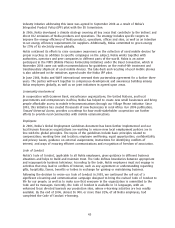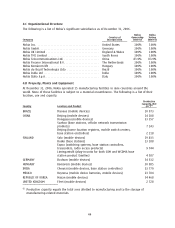Nokia 2006 Annual Report Download - page 37
Download and view the complete annual report
Please find page 37 of the 2006 Nokia annual report below. You can navigate through the pages in the report by either clicking on the pages listed below, or by using the keyword search tool below to find specific information within the annual report.network security infrastructure business. We consider our mobile device manufacturing and logistics
to be a core competence and competitive advantage.
Our Customer and Market Operations horizontal group currently operates ten mobile device
manufacturing plants in nine countries. Our Mexican and Brazilian plants primarily supply the North
and South American markets; our three European plants, located in Finland, Germany and Hungary,
principally supply Europe, the Middle East and Africa; and our two plants in China, our plant in India
and our plant in South Korea principally supply the AsiaPacific market. In addition, we have a
manufacturing plant in the United Kingdom serving Vertu.
Our manufacturing and logistics are complex, require advanced and costly equipment and include
outsourcing to third parties. During 2006, outsourcing covered on average approximately 26% of our
manufacturing volume of mobile device engines.
In the past several years, we have made significant capital investments in order to provide the
capacity required to meet demand growth. Each of our plants employs stateoftheart technology
and is highly automated. Although our plants generally manufacture for the cellular standards of
local geographic markets, each plant is capable of providing mobile devices for most of the world’s
major standards. As a result, we believe we are able to respond rapidly to the needs of different
geographic markets and to take advantage of the flexibility of a global manufacturing network. In
2006, we were able to ramp up our production considerably in order to meet the strongly increased
global demand for mobile devices.
In line with industry practice, we source a large proportion of components for our mobile devices
from a global network of suppliers. These components include electronic components, such as
integrated circuits, microprocessors, memory devices, cameras, displays, batteries and chargers; and
mechanical components, such as covers, connectors, key mats and antennas. Our products also
incorporate software provided by third parties. We and our contract manufacturers assemble
components and activate devices with our own and third party software. Final assembly typically
takes place only for firm customer orders. Certain of the components we source may experience
some price volatility from time to time. Management believes that our business relationships with
our suppliers are stable, and they typically involve a high degree of cooperation in research and
development, product design and manufacturing. See ‘‘Item 3.D Risk Factors—We depend on a
limited number of suppliers for the timely delivery of components and subassemblies and for their
compliance with our supplier requirements, such as our and our customers’ product quality, safety,
security and other standards. Their failure to do so could materially adversely affect our ability to
deliver our products and solutions successfully and on time.’’
Overall, we aim to manage our inventories to ensure that production meets demand for our
products, while minimizing inventorycarrying costs. The inventory level we maintain is a function of
a number of factors, including estimates of demand for each product category, product price levels,
the availability of raw materials, supplychain integration with suppliers, and the rate of
technological change. From time to time, our inventory levels may differ from actual requirements.
See ‘‘Item 3.D Risk Factors—Our sales and results of operations could be materially adversely affected
if we fail to efficiently manage our manufacturing and logistics without interruption, or fail to
ensure that our products and solutions meet our and our customers’ quality, safety, security and
other requirements and are delivered on time.’’
Networks
At December 31, 2006, the Networks business group had production at six plants: three in Finland,
two in China and one in India. In line with our strategy to invest resources in key areas to improve
efficiency, in our networks business some product support activities and over 50% of the whole
production is outsourced.
Nokia generally prefers to have multiple sources for its components, but Networks sources some
components for its telecommunications systems from a single or a small number of selected
36



